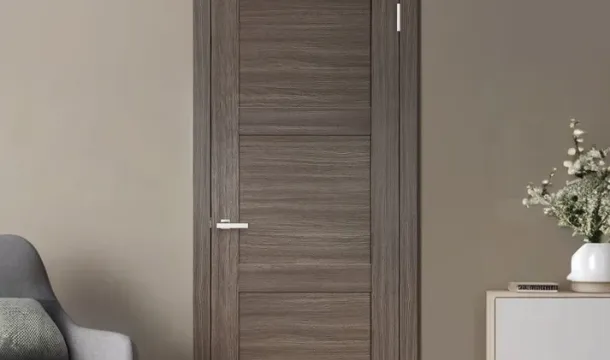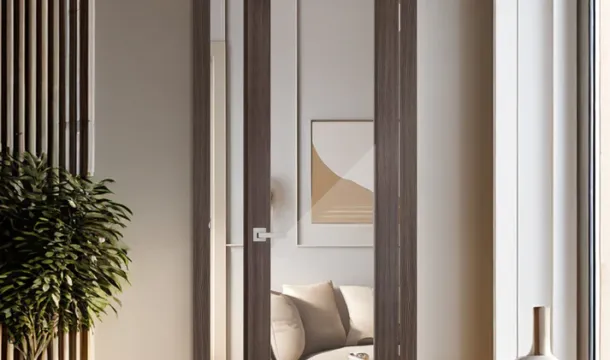How Interior Doors Influence Natural Light Flow in Your Home
Popular Articles
Selecting doors with glass panels or translucent materials significantly enhances the transmission of daylight between rooms, increasing overall brightness without sacrificing privacy. Incorporating frosted or textured glass options balances transparency and shade, allowing soft light diffusion that prevents harsh shadows while maintaining openness.
Doors positioned opposite or adjacent to windows can act as conduits for reflection, redirecting sunlight deeper into interior spaces. This technique reduces reliance on artificial lighting during daytime hours and creates a perception of expanded space through visual continuity.
Beyond illumination, door design impacts ventilation patterns essential for air circulation. Doors with louvered sections or partial openings facilitate airflow between rooms, promoting fresher environments without compromising temperature control or noise reduction.
Choosing Door Materials for Light
Select materials that maximize transparency without compromising privacy. Glass panels with frosted or textured finishes allow brightness to penetrate while diffusing direct glare and maintaining shade control. Incorporating glass inserts near a window amplifies reflection, enhancing ambient lighting throughout the space.
Wood frames combined with translucent glass balance solidity and openness, lending warmth to the design while preserving visual connection between rooms. For areas requiring more shade, consider laminated glass with adjustable opacity or integrated blinds embedded within the door structure.
Material Choices and Their Impact on Space
Acrylic and polycarbonate options offer lightweight alternatives to traditional glass, increasing diffusion of light across larger areas without heavy framing. Matte finishes reduce hotspots by scattering illumination evenly, which benefits rooms with limited external window exposure.
Metal elements can be used as accents around transparent sections to create contrast in design, but solid metal doors tend to block lighting completely and should be reserved for spaces where darkness is preferred.
Impact of Door Placement on Brightness
Position doors to align with existing windows or ventilation sources to maximize brightness across adjacent spaces. Placing openings directly opposite or perpendicular to windows enhances the penetration of daylight, utilizing transparency and reflection to brighten darker corners.
Avoid locating doors in shadowed areas where shade from structural elements or furniture limits incoming light; instead, choose placements that allow light to travel unimpeded through multiple rooms. This strategy expands perceived space by creating a visual corridor filled with natural illumination.
Consider how door orientation affects airflow as well?€"ventilation paths combined with strategic positioning facilitate light movement while maintaining fresh air circulation. For example, placing glazed doors near cross-ventilation points not only boosts brightness but also promotes a comfortable environment.
Integrating glass panels within door designs at key junctions leverages both transparency and reflection, amplifying daylight distribution without sacrificing privacy. Thoughtful placement of these translucent elements can redirect sunlight deeper into interior zones, reducing reliance on artificial lighting during daytime hours.
Glass Panels vs Solid Doors
Opt for glass-panel doors when maximizing brightness and transparency between rooms is a priority. Glass inserts enhance lighting by allowing sunlight to pass through, reducing the need for artificial sources and creating a sense of expanded space. They also contribute to ventilation if operable sections or sidelights are included.
Conversely, solid doors provide superior privacy and shade control but limit light transmission, often resulting in darker adjacent areas. Their opaque surfaces minimize reflection and prevent visual connection between spaces, which can be beneficial in bedrooms or media rooms where light blockage is desired.
- Lighting: Glass panels increase overall illumination by distributing window light deeper into interiors.
- Reflection: Smooth glass surfaces reflect ambient brightness, enhancing perceived spaciousness.
- Transparency: Clear or frosted glass balances visibility with privacy while maintaining openness.
- Design Flexibility: Options range from full-length panes to decorative muntins that complement various aesthetics without sacrificing luminosity.
- Shade Control: Solid doors block unwanted glare and offer thermal insulation advantages over transparent alternatives.
Selecting between these two depends on the desired interplay of brightness and seclusion within the layout. Combining solid frames with partial glazing can deliver a tailored balance, optimizing both daylight penetration and acoustic separation across connected zones.
Door Color and Light Reflection
Selecting a door color with high reflectivity significantly enhances the brightness within any space. Lighter shades such as soft whites, pale grays, or muted pastels bounce ambient illumination from windows and artificial lighting sources more effectively than darker tones, which tend to absorb light and create deeper shadows. This reflection not only amplifies perceived spaciousness but also supports balanced ventilation by reducing the need for additional lighting fixtures.
For rooms where maximizing daylight penetration is critical, doors painted in satin or semi-gloss finishes amplify reflection without causing glare, maintaining a comfortable shade that complements the overall design. Matte finishes, while trendy, limit reflectivity and can reduce the subtle interplay of light across surfaces.
Integrating Transparency and Shade
Incorporating transparent elements like frosted glass panels framed with lighter-colored materials combines reflection with transparency, allowing diffused lighting to permeate further into adjacent rooms. This approach maintains privacy while enhancing spatial connectivity through indirect illumination. Moreover, adjusting door color relative to window placement ensures that reflected light aligns with natural airflow patterns, optimizing both lighting and ventilation efficiency.
Avoid overly saturated hues near windows facing direct sunlight; these can cast tinted shadows that alter room ambiance and interfere with natural shade cycles essential for circadian rhythm regulation. Instead, neutral or cool-toned colors paired with strategic positioning support consistent lighting quality throughout daytime hours.
Maximizing Light with Door Design
Select door designs incorporating transparent or translucent glass inserts positioned strategically to capture and distribute daylight deeper into adjoining rooms. Frosted or textured glass can balance privacy with optimal brightness by diffusing sunlight evenly, reducing harsh shade contrasts.
Integrate sidelights or narrow vertical windows within the door frame to extend window-like effects, enhancing reflection and expanding perceived space without sacrificing wall area. Designs featuring multiple small glass panes arranged geometrically amplify light penetration while adding architectural interest.
Consider doors with adjustable ventilation elements such as louvered panels or operable vents combined with glass components; these promote airflow alongside illumination, improving indoor comfort and preventing stagnant shade pockets.
Avoid overly dense designs that create deep shades near thresholds; instead, opt for thin muntins or minimal framing around glass to maximize visible transparency. Utilizing reflective finishes on door hardware can subtly enhance brightness by bouncing light within confined areas.
Popular Articles

Soundproofing Interior Doors: Which Options Are Best for Your Home?

Choosing the Perfect Interior Doors for Your Canadian Home
